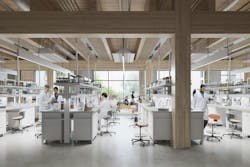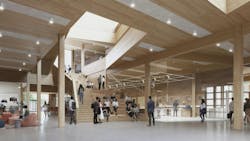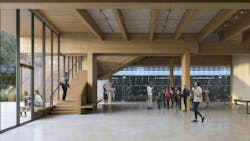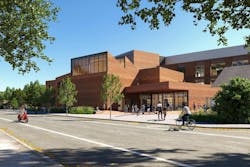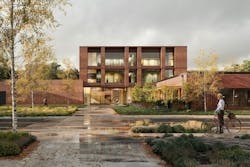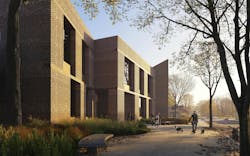Oregon State University builds a first-of-its-kind mass timber research lab
By Novid Parsi, Contributing Editor
In Corvallis, Ore., the Jen-Hsun Huang and Lori Mills Huang Collaborative Innovation Complex at Oregon State University aims to achieve a distinction among the world’s experimental research labs: It will be the first all mass timber lab meeting rigorous vibration criteria (2000 micro-inches per second, or MIPS).
Designed by ZGF Architects, the $213 million Huang Collaborative Innovation Complex, which broke ground in April, will be both a teaching center and a home for team-based transdisciplinary research on global challenges involving climate science, clean energy, and water resources. The center also will support research and learning in artificial intelligence, robotics, and materials science.
The three-level, 143,000-sf building features flexible experimental and computational laboratories, a 12,000-sf clean room, undergraduate student space, and cross-functional collaborative spaces.
The center also will harness one of the nation’s most powerful supercomputers, showcased on the public ground floor. The supercomputer’s rejected heat will help heat the building, which has the potential to become net zero operational carbon on an annual basis by 2030.
For the first-of-its-kind mass timber structure, ZGF collaborated with OSU’s College of Forestry to leverage its expertise in wood and regional forestry practices. To meet the vibration criteria of 2000 MIPS in mass timber, the project team created a structural bay in the lab interiors comprising mass timber columns, beams, and a composite deck.
This carbon-negative innovation not only provides the structural stability needed for the use of sensitive scientific equipment, it also reduces embodied carbon emissions by 108% compared to the traditional all-concrete approach. In addition, the exposed wood creates a beautiful interior environment and an inviting academic and research environment.
“We discovered over the course of planning that with careful coordination between the structure and building systems, mass timber works really well for research buildings,” Vladimir Pajkic, lead designer and partner at ZGF, said in a statement.
On the outside, electrochromic glass, in conjunction with intelligent building controls, changes tint based on the sun’s position and the level of cloudiness. Along with façade glazing and shading strategies, these smart windows increase daylight, reduce peak cooling load, and create a visually comfortable space.
On the Building Team:
Owner: Oregon State University
Design architect and architect of record: ZGF Architects
MEP engineer: AEI
Structural engineer: KPFF
General contractor: Andersen Construction
